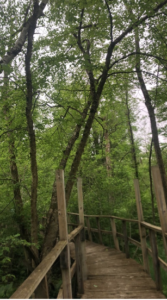Ripples written by Megan Raddatz, Woodland Dunes intern
As my tires rumble over the gravel driveway, I can hear birds chirping in the distance and it feels as though I have entered a nature lover’s utopia. I have finally arrived at the Woodland Dunes Nature Center and Preserve! Luckily enough, I arrived here as a habitat restoration intern, meaning I get to see and know all the amazing activities that go on behind the scenes. Though we all wish this was an actual utopia where everything was perfect, it is close but not yet there. No need to fear, that’s why all of the staff are here!
 Part of this restoration journey for us interns is to help plant new trees in the places where many dying ash trees currently reside. For the first few weeks, we have been planting trees off of the Yellow Birch trail in and around the swamp, just beyond the much-needed boardwalk that our visitors use.
Part of this restoration journey for us interns is to help plant new trees in the places where many dying ash trees currently reside. For the first few weeks, we have been planting trees off of the Yellow Birch trail in and around the swamp, just beyond the much-needed boardwalk that our visitors use.
Oddly enough, the yellow birch tree (scientifically known as Betula alleghaniensis), is my favorite tree. This tree is also known as golden birch or swamp birch. One of the best ways to identify the yellow birch is from its yellow/golden, peeling bark (hence the common names given to this tree). The other common name, swamp birch, comes from this tree being found near swamps. This common name is fitting for the Yellow Birch trail that we are working at and I can attest to it first-hand from trekking shovels, chicken wire, trees, and bamboo poles through the knee-high swamp!
This birch tree species is so fascinating and unique. The main reason why I like this tree is because it has a wintergreen smell and taste. It is easiest to smell and taste on the new-growth branches because the taste comes from a compound that is in a deep layer of the bark. Some people even use this tree when they are camping out in the woods and want fresh breath by chewing on the branches to get the nice wintergreen taste! With that being said, we do have to remember to save this cool fact for when we are not in a nature preserve because we do not want to disrupt the plants and animals living here.
Working out in the woods is a very exhausting but rewarding experience. It helps that I can look around and take in the fascinating plants and critters that I come across, including the yellow birch. Standing in the forest looking up at these birch trees to catch my breath from working, I remember that these trees are the longest-living native birch species. To reach heights of 60 to 70 feet tall with a beautiful broad open canopy, they prefer to grow in an area with plenty of precipitation and weather that is cool but sunny.
When looking at the trees you may notice some objects hanging off them, these are called catkins. When it comes to regeneration, yellow birch has male and female catkins borne separately on the same branch, which is referred to as monoecious. The Greek meaning of “mono” translates to “one”, and the full term means “one house”. In this process, the male and female flowers look different and have different roles that they play in regeneration, but are on the same plant, or are living in “one house”. The male catkin is long and droops down and is designed to create pollen for distribution (they drop the pollen around the same time that the trees start to bud in spring). While the female catkin, which is a more upright erect figure, develops ova which can be fertilized, resulting in the development of seeds.
The yellow birch is also an important source of hardwood lumber and a good browse plant for animals like deer, an animal so commonly found here in Wisconsin (and the reason we have to surround each tree we plant with chicken wire!). This just scratches the surface of all of the amazing uses of this tree. With so many different values it brings for the biota it is surrounded by, how can someone not consider this to be their favorite tree too?! To learn more, the Silvics of North America run by the United States Department of Agriculture, is a great resource to check out.
Photo- A yellow birch tree growing from the bottom left corner of the photo up and over the boardwalk on the Yellow Birch trail. Taken by Megan Raddatz.
